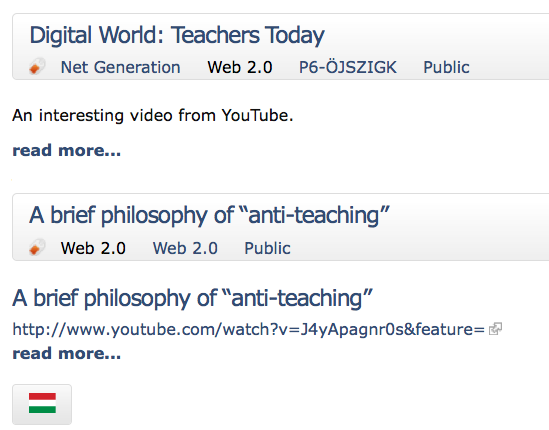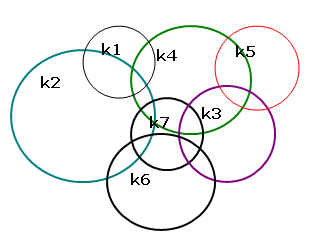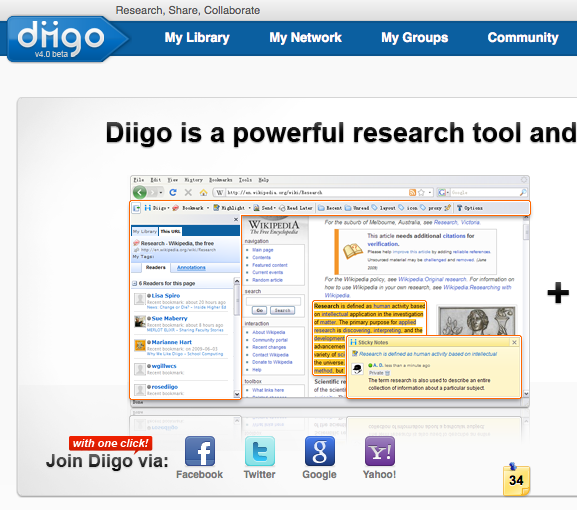E-learning concepts - Table of Content
Web 2.0
Bookmarking
 Learning Objectives
Learning Objectives
When you have completed this session, you should be able to
- understand and make informed use of the concepts of "folksonomy" and "tagging",
- compare the features of taxonomy and folksonomy,
- use social tagging and bookmarking in practice.
 Reading
Reading
Taxonomy & Folksonomy
A Taxonomy is a hierarchic classification system. We use them everwhere in our lives, for example the Windows operating system stores documents in a hierarchic classification system. The aim of this type of organisation, i.e. of establishing clear storage structures, is to be able to find things as quickly as possible when needed. This applies to many aspects of everyday activity, whether it is merchandise stored on warehouse shelves, or documents, images and other data stored digitally on hard disks.
Web 2.0 developments have brought changes, not only in respect of Internet applications, but also in the methods of organizing common storage systems too. The goal is the same: to be able to find important information as easily and as quickly as possible.
It is common nowadays to see 'word clouds' -- summaries of important information, important speeches, or even interesting web site -- where each word in the 'clouds' is sized according to its frequency of use in the underlying data. The most frequently occuring words are the largest, and each word is generally also an active link, usually to a list of the content which is somehow related to the given word (expression).
|
You see here the tags from the Tenegen portal and to the right the links related to the tags.(http://tenegen.eu) |
 Clicking on the tag "Web 2.0", a list of digital documents ranged in this category appear. |
Web 2.0 applications can offer alternative solutions for organization on-line content. Tags can be added to all images, videos and text, which relate to the underlying content. With 'clouds', for example, searching back into the content is made easy as the font size symbolizes the number of units in a given category. This kind of collaborative method of annotaing and categorizing online content - often created spontaneously - is called a folksonomy, so called as it combines an analogy of the word taxonomy with the phenomena of "social tagging".
 |
|
|
|
The 'folksonomy' side of this diagram shows a user-created cluster of meanings - in which the tags cover each other - whose structure can be illustrated by a Venn-diagram (or in the terminology of relational databases, a "many to the many" relationship). The folksonomy has the potential to account for multiple perspectives, but on the other hand there is the risk that clouds become chaotic. There can be a lot of redundacy if the concepts are not well determined, allowing for repetition. However web solutions employing social tagging methods are popular, offering some proof of its usefulness particularly with respect to making search easier on webpages.
Tagging technics
In applications that use tagging, the tags must be separated with spaces. For this simple reason complex words, and expressions having more than one word, can be difficult to tag. To solve this problem some applications allow the use of underlined gaps (for example using: _) between words (as is the case with delicious). Other approaches use quotation marks around tags with multiple words(e.g. in the link sharing diigo).
One of the most important applications of social tagging is that of social bookmarking, or simply link sharing.
 Social bookmarking
Social bookmarking
When searching on the Internet there is always the problem of finding one's way back to page visited earlier. Favorite pages can be organized within browsers, but this is not an ideal solution for two reasons. Hierarchic saving (in folders) is too strict, forcing the use of a specific, embedded categorization. Therefore during search we must often simply reply on one's memory. Secondly, if we intend to share our collection of Favourites with somone, there is no real support in the browsers.
Social bookmarking tools were developed to overcome these problems. Social bookmarks, or link sharing, are software systems, running on servers, and providing help for storing links organised with tags in some way. These systems also support the sharing of these collections with others. The video below shows how social bookmarking can be used.
Basic funcionalities of link sharing tools:
- storing, editing, deleting link descriptors (URL, descriptions, tags),
- e-mailing link descriptions to others,
- sharing links,
- searching back and listing by tags,
- share with RSS service,
- facilitating bookmark editing by built in tools in browsers.
One of the most most popular link sharing applications is Delicious, however the selection is so large that some sort of specialization has appeared. For example, there are link sharing tools that are particularly good for social cooperation (like Newswine), and other that are mainly for scientific use (like Connotea).
Diigo provides a most advanced service. It "knows" what is expected of social bookmarking and presents it in a very elegant way with many extra features. For example, it supports teamwork and is used in a highly integrated fashion. It allow supports the use of quotation marks to separate different tags, and it allows visitors to add their own comments to the entries.
 |
|
| On the Diigo website you find detailed tutorial to learn how to use it! | https://www.diigo.com/ user: tenegen, password: netgen555 |
 Exercises
Exercises
- What do you think about the potential for social bookmarking in your pedagogical practice? Would be this method be suitable for your classes in the creation of folksonomy for particular topics? Share your idea by writing these into your learning diary!
Note: Diigo is the best at supporting teamwork! Watch the YouTube video above, and visit this blog to find some useful ideas: http://www.clifmims.com/blog/ ! - Search on the Internet for useful web 2.0 tools, and share the links on Tenegen's Diigo site. (Sign in with the account given above!)

